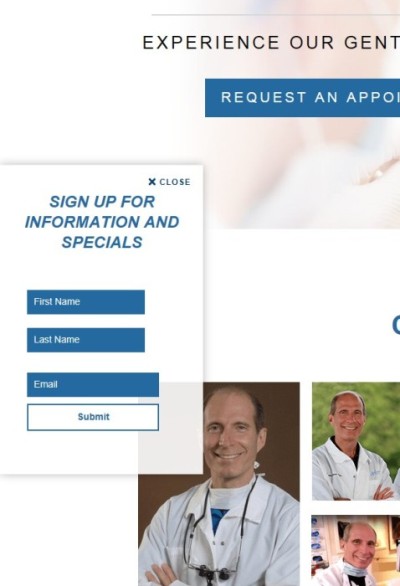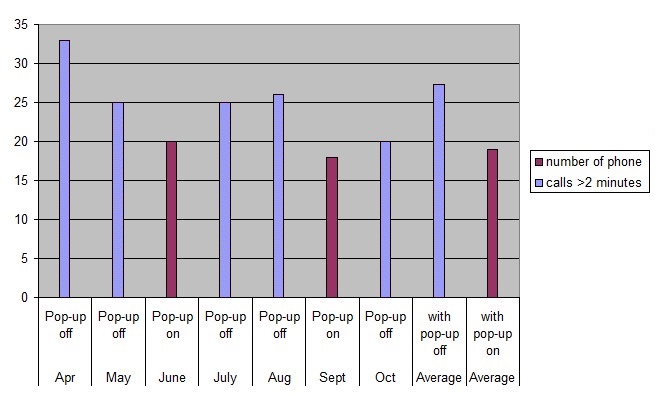How Pop-Ups Can Hurt Your Dental Website
Date: December 22, 2016Category: Author: David Hall
Some companies are pushing the use of pop-up windows on dental practice websites for one of two purposes. Either they are trying to gather email addresses for email marketing campaigns targeting people who have visited the website, or they are offering to have patients chat with someone online. These techniques obviously provide some benefits. But before you decide to add a pop-up to your website, you should know the results of a study we did here at Infinity Dental Web evaluating the effect of a pop-up window on conversion rate (i.e. the number of calls from new patients generated by the website).
Before giving you the results of our study, I’d like to start with some background information. In a 2010 study, Melanie Dempsey of Ryerson University and Andrew A. Mitchell of the University of Toronto set out to discover the power of subconscious conditioning on purchasing decisions. They created several hypothetical brands and then flooded the test subjects with images and words paired with the brands. Some brands were paired with negative images and words, others with positive. After this exposure, participants were unable to remember any of the specific associations, but they still expressed a preference for those brands that had been presented with positive associations and a dislike for those with negative associations.
In a follow-up, the study authors tried to reverse the associations with factual information and were unable to do so. Participants still preferred the products with positive subconscious associations in spite of being given information about inferior attributes of those products. Ryerson and Mitchell called this the “I like it but I don’t know why” effect, which can also become an “I don’t like it but I don’t know why” effect.
One more example before we get into our study. This was a lesson in these associations that was learned in a painful way by the Colgate-Palmolive company. In 1982 they launched a new line of frozen dinner entrees which they branded “Colgate Kitchen Entrees.” It was a classic failure and was taken off the market in less than a year. Logically, the company wanted people to make the connection that they would eat the dinner and then brush with Colgate toothpaste. And logically, there is no reason that Colgate can’t make a delicious dinner. But subconsciously and emotionally, a Colgate dinner just didn’t sound tasty because it evoked thoughts of minty fresh toothpaste.

It seems like it couldn’t hurt. But subconsciously, it has the effect of portraying you as being anxious to acquire new patients, which works against the trust you are trying to create. It’s the trust that leads people to call. (For background information on this subject, please see my blog post, “Dentists – how to sell trust.”)
To the left is a pop-up that one of our clients wanted to run to try to collect e-mail addresses from prospective patients. We made the popup as unobtrusive as possible, to avoid any feeling of annoyance by website visitors. It was placed on the left side, not covering any key content, with a plainly marked “close” button. To see whether this was having a negative effect at all, the client let us run a study. Over a period of seven months, we had periods of time when the pop-up was present and periods when it wasn’t.
Here is a chart of the impact this had on the rate of phone calls generated by the website using our call tracking software:
We counted the number of calls to the call tracking number that were more than two minutes in length. That is a good guideline to follow when monitoring new patient appointment phone calls. We should add that for this client, they get many more than this number of new patient calls from their website, it’s just that only about a quarter to half of the people actually follow the instructions to use the call tracking phone number. But the sampling gives us a good indication of the effect of the pop-up.
You can see that whenever the pop-up was present, the number of calls were down. During the five months there was no pop-up, they averaged 27.25 call tracking calls per month. With the pop-up, they averaged 19 calls per month–about 30% less.
Award-winning marketing expert Douglas Van Praet, in his book Unconscious Branding, discusses the Dempsey/Mitchell study I mention above, as well as the “Colgate Kitchen Entrees” failure, and then mentions website pop-ups as an application of the “I don’t like it but I don’t know why” effect. He says:
“One of the most pervasive and alarming trends in digital marketing these days is forced exposure to online advertising–those annoying pop-up windows, ads, and links that stand like roadblocks between you and your desired content. Rather than just creating awareness of the product, these intrusions train people to associate and link negative emotions like anger and frustration to the brand. After countless annoying exposures, advertisers might see an increase in brand awareness but they may also see the results of negative conditioning, i.e. the ‘I don’t like this brand, but I don’t know why’ effect.”
However, what we have in this pop-up study isn’t an annoying ad that gets in the way of your desired content. When the pop-up was displayed, the bounce rate for the home page was not affected which indicates that people aren’t getting annoyed because they’re staying on the site. This is a more subtle effect. The problem with this pop-up is that it reveals an eagerness for the visitor to choose this dentist, which detracts from the feelings of professionalism and trust that we are trying to create with the website.
Should you try to collect e-mail addresses from your visitors with a pop-up? There may be some cases where it would be helpful. There could be a benefit in being able to email visitors later and try to get them to schedule. But there is clearly a cost in a decreased conversion rate of the website. Evaluate that cost before you decide.



Thank you, Dr. Hall, for performing this study and sharing. I’ve long suspected this, and appreciate some data to back myself up. Popups do not convey the right message about a professional and make it appear that we have so little faith in the professional that we have to go after leads in this way to get them to make an appointment.
Often the justification given is that the marketer can get leads this way, by collecting emails like this. But you are showing that there is a cost. Are we losing something that is more important than that email address?
While popups may still be a good option for some, it is important to know these costs. I also suspect that we may lose loyal patients who may visit the site several times and see the popup each time. These loyal patients may be the ones making patient referrals. They are more valuable than one more email address.
In your analytics, you’ll be seeing some links to this page from AlreadyContent.com/blog, which focuses largely on improving customer experience in marketing.